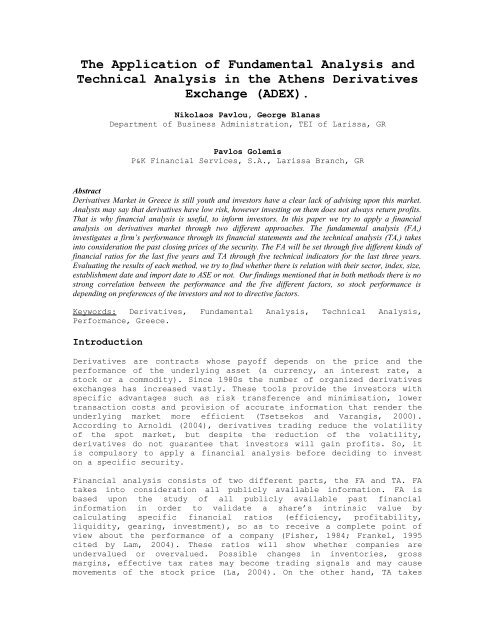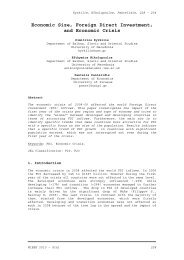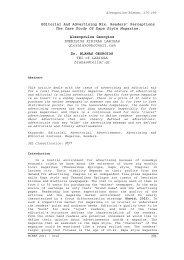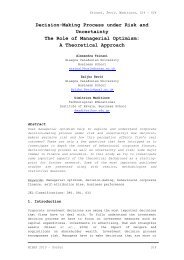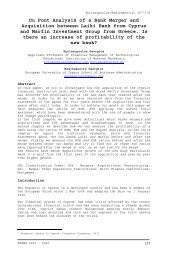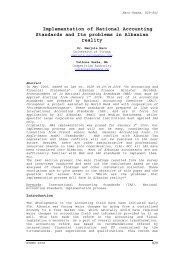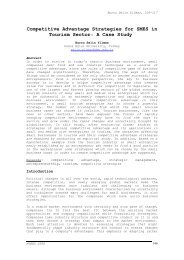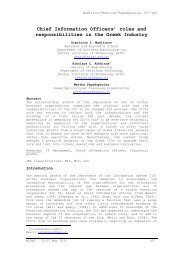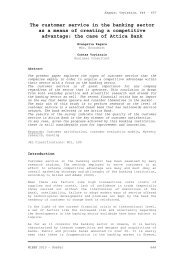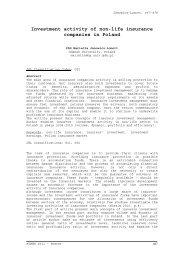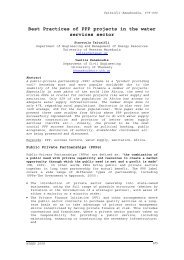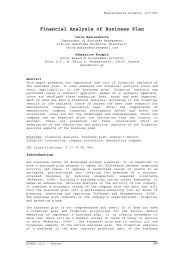The Application of Fundamental Analysis and Technical ... - mibes
The Application of Fundamental Analysis and Technical ... - mibes
The Application of Fundamental Analysis and Technical ... - mibes
You also want an ePaper? Increase the reach of your titles
YUMPU automatically turns print PDFs into web optimized ePapers that Google loves.
<strong>The</strong> <strong>Application</strong> <strong>of</strong> <strong>Fundamental</strong> <strong>Analysis</strong> <strong>and</strong><br />
<strong>Technical</strong> <strong>Analysis</strong> in the Athens Derivatives<br />
Exchange (ADEX).<br />
Nikolaos Pavlou, George Blanas<br />
Department <strong>of</strong> Business Administration, TEI <strong>of</strong> Larissa, GR<br />
Pavlos Golemis<br />
P&K Financial Services, S.A., Larissa Branch, GR<br />
Abstract<br />
Derivatives Market in Greece is still youth <strong>and</strong> investors have a clear lack <strong>of</strong> advising upon this market.<br />
Analysts may say that derivatives have low risk, however investing on them does not always return pr<strong>of</strong>its.<br />
That is why financial analysis is useful, to inform investors. In this paper we try to apply a financial<br />
analysis on derivatives market through two different approaches. <strong>The</strong> fundamental analysis (FA,)<br />
investigates a firm’s performance through its financial statements <strong>and</strong> the technical analysis (TA,) takes<br />
into consideration the past closing prices <strong>of</strong> the security. <strong>The</strong> FA will be set through five different kinds <strong>of</strong><br />
financial ratios for the last five years <strong>and</strong> TA through five technical indicators for the last three years.<br />
Evaluating the results <strong>of</strong> each method, we try to find whether there is relation with their sector, index, size,<br />
establishment date <strong>and</strong> import date to ASE or not. Our findings mentioned that in both methods there is no<br />
strong correlation between the performance <strong>and</strong> the five different factors, so stock performance is<br />
depending on preferences <strong>of</strong> the investors <strong>and</strong> not to directive factors.<br />
Keywords: Derivatives, <strong>Fundamental</strong> <strong>Analysis</strong>, <strong>Technical</strong> <strong>Analysis</strong>,<br />
Performance, Greece.<br />
Introduction<br />
Derivatives are contracts whose pay<strong>of</strong>f depends on the price <strong>and</strong> the<br />
performance <strong>of</strong> the underlying asset (a currency, an interest rate, a<br />
stock or a commodity). Since 1980s the number <strong>of</strong> organized derivatives<br />
exchanges has increased vastly. <strong>The</strong>se tools provide the investors with<br />
specific advantages such as risk transference <strong>and</strong> minimisation, lower<br />
transaction costs <strong>and</strong> provision <strong>of</strong> accurate information that render the<br />
underlying market more efficient (Tsetsekos <strong>and</strong> Varangis, 2000).<br />
According to Arnoldi (2004), derivatives trading reduce the volatility<br />
<strong>of</strong> the spot market, but despite the reduction <strong>of</strong> the volatility,<br />
derivatives do not guarantee that investors will gain pr<strong>of</strong>its. So, it<br />
is compulsory to apply a financial analysis before deciding to invest<br />
on a specific security.<br />
Financial analysis consists <strong>of</strong> two different parts, the FA <strong>and</strong> TA. FA<br />
takes into consideration all publicly available information. FA is<br />
based upon the study <strong>of</strong> all publicly available past financial<br />
information in order to validate a share’s intrinsic value by<br />
calculating specific financial ratios (efficiency, pr<strong>of</strong>itability,<br />
liquidity, gearing, investment), so as to receive a complete point <strong>of</strong><br />
view about the performance <strong>of</strong> a company (Fisher, 1984; Frankel, 1995<br />
cited by Lam, 2004). <strong>The</strong>se ratios will show whether companies are<br />
undervalued or overvalued. Possible changes in inventories, gross<br />
margins, effective tax rates may become trading signals <strong>and</strong> may cause<br />
movements <strong>of</strong> the stock price (La, 2004). On the other h<strong>and</strong>, TA takes
into account only the price movements <strong>and</strong> totally ignores the<br />
fundamental factors. Examining the daily prices, investors can extract<br />
different kinds <strong>of</strong> indicators such as MA, RSI, Momentum, PO <strong>and</strong> MV in<br />
order to conclude whether the specific security presents any kind <strong>of</strong><br />
trend (Thomsett, 1999 cited by Lam, 2004). <strong>The</strong> important factor is not<br />
only the invention <strong>of</strong> a possible trend, but also its directional<br />
movement <strong>and</strong> its strength. Finally, several buy <strong>and</strong> sell signals can be<br />
extracted studying these indicators <strong>and</strong> make investors’ choices more<br />
accurate <strong>and</strong> safe.<br />
<strong>The</strong> purpose <strong>of</strong> this paper is to highlight whether derivatives returns<br />
are connected with the results <strong>of</strong> FA <strong>and</strong> TA <strong>and</strong> whether these two<br />
methods provide similar information to investors or each one opposes<br />
the other. Also we study the relation between SEC, IND, SIZ, EST <strong>and</strong><br />
IMP with the FA <strong>and</strong> TA results. In order to highlight these issues,<br />
this paper is divided into the following sectors. Specifically, in the<br />
next part we mention the previous research similar to our topic. Next,<br />
we mention theory about financial ratios <strong>and</strong> in the last part we<br />
present some findings based on our practice.<br />
In order to become more accurate, we apply the financial analysis to<br />
the underlying market <strong>and</strong> not to derivatives, because derivatives<br />
market depends on premium <strong>and</strong> discounts <strong>of</strong> the contracts. That is the<br />
closing price is used to calculate the every day premium or discount<br />
(depends on yesterday price) in relation to the clearance price. It is<br />
important to mention that derivatives perform almost the same as the<br />
underlying asset they come from.<br />
Literature Review<br />
Nowadays, that more <strong>and</strong> more people are interested about stock<br />
exchange’s performance, financial analysis prevents them from investing<br />
their capital on wrong securities <strong>and</strong> bear the bias they introduce<br />
(Conesa <strong>and</strong> Martinez, 2004). Diachronically, academics are applying<br />
different kinds <strong>of</strong> financial analysis. Others give emphasis to the<br />
performance <strong>of</strong> the company (FA), others to the stock performance (TA)<br />
<strong>and</strong> others to both <strong>of</strong> them. We present the corresponding background<br />
research on FA <strong>and</strong> TA analysis in the next paragraphs.<br />
Ming (1984) searched how both FA <strong>and</strong> TA affected stock prices. HKSE in<br />
1980s was an emerging market as ASE is today. He concluded that FA<br />
produced good results while TA was used as a supplementary tool. He<br />
mentioned that following trends or indicators blindly is like playing<br />
in a casino. He concluded that signals <strong>and</strong> forecasts from FA based on<br />
firms’ performance are essential for a successful investment.<br />
Lee (1987) studied the reaction <strong>of</strong> 120 companies listed in NYSE <strong>and</strong> in<br />
AMEX from July 1978 until the December <strong>of</strong> 1981 to the FA. <strong>The</strong><br />
hypothesis tested whether buy <strong>and</strong> sell signals in favorable <strong>and</strong><br />
unfavorable analysis respectively, would lead investors to hold a long<br />
position in favorable stocks or short position in unfavorable stocks.<br />
He came to a conclusion that market reacts to the signals <strong>of</strong> the<br />
fundamental analysis <strong>and</strong> its performance is closely connected with the<br />
results <strong>of</strong> accounting statements. <strong>The</strong> relation <strong>of</strong> FA <strong>and</strong> stock market<br />
performance drew the attention <strong>of</strong> several academics around the world<br />
<strong>and</strong> not only in US. Mukherji, Dhatt <strong>and</strong> Kim (1997), applied a FA <strong>of</strong>
Korean stock returns during the period 1982 <strong>and</strong> 1993. <strong>The</strong>y constructed<br />
six ratios (Beta, D/E, E/P, B/M, MVE <strong>and</strong> S/P). <strong>The</strong>y concluded that FA<br />
is positively correlated with B/M, S/P <strong>and</strong> D/E <strong>and</strong> negatively<br />
correlated with E/P <strong>and</strong> Beta. <strong>The</strong>se results are coherent with findings<br />
<strong>of</strong> recent studies in several international markets (Park, 2005; Weig<strong>and</strong><br />
<strong>and</strong> Irons, 2004; Fatemi, Desai <strong>and</strong> Katz, 2003). Also, B/M <strong>and</strong> S/P are<br />
more reliable indicators <strong>of</strong> fundamental value than E/P. <strong>The</strong>se findings<br />
indicate that greater leverage <strong>and</strong> smaller size result in greater<br />
returns. Choi (1995), applied a comparative FA <strong>of</strong> US <strong>and</strong> Japan stock<br />
prices, by constructing five financial ratios (P/E, P/CF, P/BV, Capital<br />
Gains <strong>and</strong> Dividend Yield) for the period 1974 to 1989. P/E ratio is 2,5<br />
times higher in Japan than in US while P/BV <strong>and</strong> P/CF are also higher in<br />
Japan. According to French <strong>and</strong> Poterba (1991) cited by Choi (1995),<br />
higher ratios in Japan, are based on different accounting practices<br />
(Japanese firms report earnings only for the parent company while US<br />
firms report consolidated earnings). Also dividend payments are lower<br />
in Japan than in US, but stock prices increases are higher <strong>and</strong> so<br />
capital gains are higher. Lam (2002), tried to find out whether firm<br />
size, B/M <strong>and</strong> P/E ratio are related with stock returns in HKSE. <strong>The</strong><br />
data consists <strong>of</strong> 100 listed firms in HKSE for the period July 1980 till<br />
June 1997. <strong>The</strong> results showed that the above accounting variables were<br />
able to define the cross sectional variation in average returns over<br />
the period.<br />
Wong, Manzur <strong>and</strong> Chew (2003), tried to clarify the role <strong>of</strong> technical<br />
analysis in SSE. <strong>The</strong>y examined the daily closing prices for the period<br />
1 January 1974 till 31 December 1994 by applying two different<br />
technical indicators, MA <strong>and</strong> RSI. <strong>The</strong>y concluded that technical<br />
indicators can create useful buy <strong>and</strong> sell signals <strong>and</strong> members <strong>of</strong> SSE<br />
can gain effective pr<strong>of</strong>its. It is important to mention that SSE members<br />
have their own trading team that its results are based on technical<br />
analysis. TA is also efficient for foreign exchange markets.<br />
Specifically, Papadamou <strong>and</strong> Tsopoglou (2001), examined the performance<br />
<strong>of</strong> different technical indicators on daily spot exchange rates for<br />
USD/DM <strong>and</strong> USD/BP for the period 3/1/1989 to 31/12/1996. <strong>The</strong>y used<br />
three different indicators, MA, Momentum <strong>and</strong> MACD, to get out the<br />
appropriate buy <strong>and</strong> sell signals. All signals proved to be successful<br />
<strong>and</strong> reliable. Also, the weakness <strong>of</strong> FA to provide reliable signals for<br />
exchange rates lead analysts to use TA (Papadamou <strong>and</strong> Tsopoglou, 2001).<br />
Furthermore, TA has applicability to currency emerging markets.<br />
Specifically, Ahmed, Beck <strong>and</strong> Goldreyer, (2005), tested currency spot<br />
rates for Mexico, Chile, Thail<strong>and</strong>, Indonesia, South Korea <strong>and</strong><br />
Philippines during the period 2 January 1990 till 10 November 2000.<br />
<strong>The</strong>y used VMA <strong>and</strong> they found substantial returns through buy <strong>and</strong> sell<br />
signals, even when the currency market fell. Past research <strong>and</strong> results<br />
from this study detect that technical trading rules in emerging markets<br />
perform significant pr<strong>of</strong>its. Zenker (2003), studied the performance <strong>of</strong><br />
TA applied to the airline industry. <strong>The</strong> basis point was the 11/9/2001<br />
<strong>and</strong> the pre <strong>and</strong> post performance <strong>of</strong> the airlines industries. Applying<br />
ten different technical indicators, he concluded that TA can predict<br />
future movements, but it is difficult to make 100% accurate predictions.<br />
Data <strong>and</strong> Methodology<br />
All data, accounting statements <strong>and</strong> daily closing prices, come from the<br />
ASE database. We use accounting statements for listed companies in the
indexes which derivatives are traded in (Ftse-20, Ftse-40 <strong>and</strong> Eps-50)<br />
from 2001 till 2005 (we do not use 2006 because 6 months statements may<br />
give manipulative results). Regarding daily closing prices, we use the<br />
three above indexes <strong>and</strong> all underlying assets that derivatives (futures<br />
<strong>and</strong> options) come from, for the period 4 August 2003 till 8 August 2006<br />
because during that period ASE recovered from the big downfall coming<br />
from the prices’ explosion in 1999.<br />
<strong>The</strong> methodology is based on Samaras, Matsatsinis <strong>and</strong> Zopunidis (2005).<br />
Specifically, in order to execute the FA, we apply a financial analysis<br />
<strong>of</strong> listed companies through the financial ratios method. As mentioned<br />
above, in order to execute FA <strong>and</strong> TA for derivatives, it is essential<br />
to apply the FA <strong>and</strong> TA to the underlying asset. So, listed companies in<br />
the three indexes (Ftse-20, Ftse-40 <strong>and</strong> Eps-50) are divided into three<br />
categories according to their main business, banks, industrial <strong>and</strong><br />
insurance companies. <strong>The</strong> appropriate financial ratios for each company<br />
are created in order to classify the firms into three categories by<br />
their performance: good, fair <strong>and</strong> not good. This classification arises<br />
from the calculation <strong>of</strong> the 18 ratios <strong>and</strong> their ranking in 0 for not<br />
available, 1 for bad, 2 for fair <strong>and</strong> 3 for good. So aggregating the<br />
ranking <strong>of</strong> all ratios, firms are classified in the above three<br />
categories.<br />
TA is based upon the daily closing prices <strong>of</strong> the above three indexes<br />
<strong>and</strong> the stocks on which derivatives’ products has been created. Using<br />
the appropriate s<strong>of</strong>tware (Metastock Pr<strong>of</strong>essional 9.0), we calculate 3<br />
ratios (trade efficiency, Risk Reward ratio <strong>and</strong> Pr<strong>of</strong>it Loss ratio) <strong>and</strong><br />
we classify these ratios in three ranks, 0 for bad (negative returns),<br />
1 for fair (0%-50% returns) <strong>and</strong> 2 for good (50%-100% returns). So<br />
aggregating these three ratios, we calculate each stock’s performance,<br />
which is divided into three classes, bad, fair <strong>and</strong> good.<br />
<strong>The</strong> results <strong>of</strong> FA <strong>and</strong> TA are connected with SEC, IND, SIZ, EST <strong>and</strong> IMP<br />
in order to conclude whether the performance is correlated with each <strong>of</strong><br />
these factors or not. Finally, the results will be based on the<br />
underlying market but the application to derivatives is efficient<br />
because these two markets follow the same trend, upward or downward.<br />
Financial Ratios<br />
<strong>The</strong> FA is based on the calculation <strong>and</strong> the evaluation <strong>of</strong> financial<br />
ratios. <strong>The</strong>y provide analysts with elements about the efficiency <strong>and</strong><br />
the performance <strong>of</strong> a company or even specific sectors <strong>of</strong> a firm. But<br />
ratios on their own, are just numbers <strong>and</strong> only by comparing them with<br />
ratios <strong>of</strong> past years or with ratios <strong>of</strong> other departmental firms, can<br />
someone underst<strong>and</strong> their significance (Niarchos, 1989, p.215).<br />
According to Ming (1984), in order to draw a clear view <strong>of</strong> a firm’s<br />
performance, there should be calculated five different kinds <strong>of</strong> ratios,<br />
efficiency, pr<strong>of</strong>itability, liquidity, gearing <strong>and</strong> investment. <strong>The</strong> most<br />
common used ratios are illustrated in table 1 (see appendix).<br />
While table 1 contains ratios for the industrial companies, table 2<br />
(see appendix), presents banking ratios which differentiate from the<br />
others because all their financial statements are based on the banking<br />
accounting plan. In the banking balance sheet major role play the<br />
savings which belong to the claims. <strong>The</strong>se savings are used by the banks
to fund their allowances, their cash <strong>and</strong> their placements on<br />
securities. <strong>The</strong> difference between the average savings’ interest <strong>and</strong><br />
the average allowances’ interest is the so called spread which<br />
comprises the basic revenue source. According to this thought, in table<br />
2 there are presented the ratios for banking institution.<br />
Empirical Findings<br />
<strong>The</strong> results <strong>of</strong> the financial ratios’ calculation <strong>and</strong> examination for<br />
the industrial firms indicated that most <strong>of</strong> the companies’ performance<br />
is not correlated with SEC, IND, SIZ, EST <strong>and</strong> IMP in ASE (see appendix,<br />
table 1). Specifically, only the correlation with IND is positive (p=<br />
0,271), while all the other correlations are slightly negative. But may<br />
the correlation give the relation between variables the so called<br />
partial correlation is a more reliable statistic measure as it shows<br />
the relation <strong>of</strong> two variables without ignoring the other variables but<br />
taking them into account. Specifically, calculating partial<br />
correlations, we realised that the connection between the performance<br />
<strong>and</strong> the independent variables became a little stronger. This<br />
measurements show the true relation between dependent <strong>and</strong> independent<br />
variables. Also, may the performance depend on financial ratios, but<br />
some <strong>of</strong> them have a more severe impact on it. Specifically, investment<br />
<strong>and</strong> pr<strong>of</strong>itability ratios are stronger correlated with performance (p=<br />
0,6 <strong>and</strong> p= 0,42 respectively).<br />
<strong>The</strong> most common used statistic measure is the regression. We ran a<br />
regression using the performance as a dependent variable <strong>and</strong> the above<br />
five variables as independent. As shown in Table 3, the sig. is 0,091,<br />
so the model is applicable to a 90% confidence interval. <strong>The</strong> R= 0,404<br />
shows the relationship between the dependent an independent variables.<br />
<strong>The</strong> R 2 = 0,14 coefficient shows that only 14% <strong>of</strong> the variability <strong>of</strong> the<br />
prices are explained by the regression model. As a result, in<br />
Coefficients table, we notice that only IND coefficient is reliable<br />
(sig.= 0,014). In ANOVA table, the F statistic tests whether the<br />
independent variables explain the variability <strong>of</strong> the dependent<br />
variable’s prices. <strong>The</strong> number 2,009 is low <strong>and</strong> the probability <strong>of</strong> error<br />
is high.<br />
Using the t- test, we check whether the mean performance is the same in<br />
different IND, SEC <strong>and</strong> SIZ. We found that the average performance is<br />
unequal in different IND (sig.= 0,029), while the mean performance is<br />
the same in different SEC (sig.= 0,655) <strong>and</strong> in different SIZ (sig.=<br />
0,243).<br />
We did not mention above the banks, because we calculated different<br />
financial ratios according to the banking accounting plan. Studying<br />
these ratios we concluded that the correlation between the performance<br />
<strong>and</strong> IND, SIZ, EST <strong>and</strong> IMP is weak (see appendix, table 5).<br />
Specifically, the correlation with IND is negative while with the other<br />
here variables are weakly positive. In order to provide a more accurate<br />
view <strong>of</strong> the relation between the variables, we calculated the partial<br />
correlation which mentioned stronger correlation. Also we ran a<br />
regression but the results were disappointing because F statistic was<br />
only 0,409 which underlines that the independent variables can not<br />
explain possible variability in performance’s prices.
After the examination <strong>of</strong> FA, we applied a TA through five different<br />
technical indicators, DM, MACD, Momentum, RSI <strong>and</strong> TrA. We calculated<br />
three ratios to test TRE, the R/R <strong>and</strong> the P/L. We examined the<br />
correlation between the performance <strong>and</strong> the different variables, SEC,<br />
IND, SIZ, EST <strong>and</strong> IMP. In table 6 there are summarised the<br />
correlations. In none <strong>of</strong> the indicators’ results, the correlation is<br />
strong or even semi strong. <strong>The</strong>y are all close to zero (no<br />
correlation), other positive <strong>and</strong> other negative. Again, by applying the<br />
partial correlation, we notice that the correlation are becoming little<br />
stronger but they still remain weak.<br />
We ran a regression for the results <strong>of</strong> different indicator <strong>and</strong> the only<br />
which produced primary reliable results was the DM. Specifically, the<br />
sig.= 0,030 mentions that results are reliable for a 95% confidence<br />
interval, but the F statistic= 2,653 is low <strong>and</strong> probability <strong>of</strong> error is<br />
possible. Also, the size <strong>and</strong> sector coefficients produce reliable<br />
results. Using the t- test, we examined the relationship <strong>of</strong> mean<br />
performance <strong>and</strong> the different SEC, IND, SIZ, EST <strong>and</strong> IMP. We found that<br />
the mean performance is the same for all variables from each indicator<br />
except from the size from MACD which mean performance was different in<br />
different firm size (sig.= 0,049). Finally, we examined whether the<br />
performance <strong>of</strong> different indicators is independent using the Chi-Square<br />
test. We found that all variables are independent (see appendix, table<br />
7).<br />
<strong>The</strong> performance as said in the methodology is depending on the three<br />
ratios. But applying a correlation <strong>of</strong> each performance with its<br />
corresponding ratios, we found that performance is strongly correlated<br />
first with R/R, second with P/L <strong>and</strong> last with TRE, which correlation is<br />
a lot weaker than the other two. Also, trying a correlation test<br />
between the performances isolate, we did not confirm any strong<br />
correlation or even semi strong. <strong>The</strong> relationship between them was<br />
minimal, almost zero.<br />
Conclusion<br />
In this paper, we applied FA <strong>and</strong> TA on derivatives. We calculated<br />
eighteen different financial ratios for all the listed companies in<br />
Fste-20, Ftse-40 <strong>and</strong> Eps-50 <strong>and</strong> we found out whether there are any<br />
special relations between firms’ performance <strong>and</strong> SEC, IND, SIZ, EST <strong>and</strong><br />
IMP. Based on our results, there is very weak correlation between these<br />
variables. <strong>The</strong> FA performance is mostly affected by pr<strong>of</strong>itability <strong>and</strong><br />
investment ratios <strong>and</strong> less by the other kind <strong>of</strong> ratios. We examined<br />
banks according to the banking accounting plan <strong>and</strong> we calculated eleven<br />
financial ratios. <strong>The</strong> results are equal to industrial firms’ results<br />
<strong>and</strong> their performance is not depending exclusively on any <strong>of</strong> the above<br />
factors. Regarding TA, the five different indicators produced three<br />
ratios which again as in FA did not mention any special relation<br />
between dependent <strong>and</strong> independent variables. Also examining the<br />
performance <strong>of</strong> FA <strong>and</strong> the five different TAs, we do not find any<br />
special relation, that is FA <strong>and</strong> TA behave in different ways. So, FA<br />
<strong>and</strong> TA results mention that stock performance is not getting affected<br />
by variables connected with the specific stock but it is a matter <strong>of</strong><br />
dem<strong>and</strong> <strong>and</strong> supply <strong>of</strong> the investors’ preferences. <strong>The</strong> stocks are not<br />
behaving the same as other stocks which have some equal<br />
characteristics, but the movements (upward or downward) depend on the
specific attributes <strong>of</strong> the particularly stock.<br />
In this paper everything evolved around stocks <strong>and</strong> not around<br />
derivatives products. This happened because the stock market from which<br />
derivatives are created is the base for derivatives progress <strong>and</strong><br />
performance. That is, derivatives tend to behave the same as the<br />
underlying asset, either upward or downward. So the above results st<strong>and</strong><br />
also for derivatives <strong>and</strong> we can conclude that derivatives products <strong>of</strong><br />
the same SEC, IND, SIZ, EST, IMP are not behaving equally, but each<br />
contract follows a different route according to the dem<strong>and</strong> <strong>and</strong> supply<br />
<strong>of</strong> the investors.<br />
Acknowledgements<br />
This research has been carried out under the auspices <strong>of</strong> the ARCHIMEDES<br />
project that is co-funded by the European Social Fund <strong>and</strong> National<br />
Resources- EPEAEK II
References<br />
Ahmed, P., K. Beck <strong>and</strong> E. Goldreyer, 2005, “Moving Average <strong>Technical</strong><br />
Trading Strategies for Currencies <strong>of</strong> Emerging Economies”, Managerial<br />
Finance, 31(5), 14-27.<br />
Arnoldi, J., 2004, “Derivatives, Virtual Values <strong>and</strong> Real Risks”,<br />
<strong>The</strong>ory, Culture & Society, 21(6), 23-42.<br />
Choi, J.J, 1995, “<strong>The</strong> Japanesse <strong>and</strong> US Stock Returns: A Comparative<br />
<strong>Fundamental</strong> <strong>Analysis</strong>”, Japan <strong>and</strong> the World Economy, 7, 347-360.<br />
Fatemi, A., Desai, A.S. <strong>and</strong> Katz, P. (2003), “Wealth creation <strong>and</strong><br />
managerial pay: MVA <strong>and</strong> EVA as determinants <strong>of</strong> executive compensation”,<br />
Global Finance Journal, 14, 159-179.<br />
Fischer, K.A., 1984, “Super Stocks”, Dow Jones-Irwin, Illinois. In Lam,<br />
M., 2004, Neural Network Techniques for Financial Performance<br />
Predictions: Integrating <strong>Fundamental</strong> <strong>and</strong> <strong>Technical</strong> <strong>Analysis</strong>”,<br />
Decision Support Systems, 37, 567-581.<br />
Frankel, J.A., 1995, “Financial Markets <strong>and</strong> Monetary Policy”, MIT<br />
Press, Massachusetts. In Lam, M., 2004, Neural Network Techniques for<br />
Financial Performance Predictions: Integrating <strong>Fundamental</strong> <strong>and</strong><br />
<strong>Technical</strong> <strong>Analysis</strong>”, Decision Support Systems, 37, 567-581.<br />
French, K. <strong>and</strong> J. Poterba, 1991, “Were Japanese Stock Prices Too<br />
High?”, Journal <strong>of</strong> Financial Economics, 29, 337-364. In Choi, J.J,<br />
1995, “<strong>The</strong> Japanesse <strong>and</strong> US Stock Returns: A Comparative <strong>Fundamental</strong><br />
<strong>Analysis</strong>”, Japan <strong>and</strong> the World Economy, 7, 347-360.<br />
Lam, K.S.K., 2002, “<strong>The</strong> relationship between size, book-to-market<br />
equity ratio, earnings–price ratio, <strong>and</strong> return for the Hong Kong<br />
stock market”, Global Finance Journal, 13, 163-179.<br />
Lam, M., 2004, Neural Network Techniques for Financial Performance<br />
Predictions: Integrating <strong>Fundamental</strong> <strong>and</strong> <strong>Technical</strong> <strong>Analysis</strong>”,<br />
Decision Support Systems, 37, 567-581.<br />
Lee, C.J., 1987, “<strong>Fundamental</strong> <strong>Analysis</strong> <strong>and</strong> the Stock Market”, Journal<br />
<strong>of</strong> Business Finance & Accounting, 14(1), 131-141.<br />
Martinez Conesa, I. <strong>and</strong> E. Ortiz Martinez, 2004, “International<br />
Financial <strong>Analysis</strong> <strong>and</strong> the H<strong>and</strong>icap <strong>of</strong> Accounting Diversity”,<br />
European Business Review, 16(3), 272-291.<br />
Mukherji, S., M.S. Dhatt <strong>and</strong> Y.H. Kim, 1997, “A <strong>Fundamental</strong> <strong>Analysis</strong> <strong>of</strong><br />
Korean Stock Returns”, Financial Analysts Journal, May/June, 75-80.<br />
Niarchos, N.A., 1989, Financial <strong>Analysis</strong> <strong>of</strong> Accounting Statements,<br />
Peiraias, Greece, Stamoulis eds.<br />
Papadamou, S. <strong>and</strong> S. Tsopoglou, 2001, “Investigating the Pr<strong>of</strong>itability<br />
<strong>of</strong> <strong>Technical</strong> <strong>Analysis</strong> Systems on Foreign Exchange Markets”,<br />
Managerial Finance, 27(8), 63-78.<br />
Park, C., 2005, “Stock Returns <strong>and</strong> the Dividend-Price Ratio: Has the<br />
Predictive Relation Been Stable during the 1990s?”, Department <strong>of</strong><br />
Economics, National University <strong>of</strong> Singapore.<br />
Samaras, G.D., N.F. Matsatsinis <strong>and</strong> C. Zopounidis, 2005, “A<br />
Multicriteria DSS for a Global Stock Evaluation”, Operational<br />
Research International Journal, 3(3), 281-306.<br />
Thomsett, M.C., 1999, “Mastering <strong>Technical</strong> <strong>Analysis</strong>, A Kaplan<br />
Pr<strong>of</strong>essional”, Chicago. In Lam, M., 2004, Neural Network Techniques<br />
for Financial Performance Predictions: Integrating <strong>Fundamental</strong> <strong>and</strong><br />
<strong>Technical</strong> <strong>Analysis</strong>”, Decision Support Systems, 37, 567-581.<br />
Tsetsekos, G. <strong>and</strong> P. Varangis, 2000, “Lessons in Structuring<br />
Derivatives Exchange”, <strong>The</strong> World Bank Research Observer, 15(1), 85-<br />
98.
Weig<strong>and</strong>, R.A. <strong>and</strong> Irons, R., 2005, “Forecasting Stock Returns Using the<br />
Market P/E Ratio”, (under review at the Journal <strong>of</strong> Portfolio<br />
Management).<br />
Wong, W.K., M. Manzur <strong>and</strong> B.K. Chew, 2003, “How Rewarding is <strong>Technical</strong><br />
<strong>Analysis</strong>? Evidence from the Singapore Market”, Applied Financial<br />
Economics, 13, 543-551.<br />
Zenker, C., 2003, “Case Study: <strong>Technical</strong> Stock <strong>Analysis</strong> Applied tot the<br />
Airline Industry”, Doctoral Seminar, University <strong>of</strong> St. Gallen.<br />
Curriculum Vitae<br />
My name is Nikolaos Pavlou <strong>and</strong> I am a graduate <strong>of</strong> the Department <strong>of</strong><br />
Economics in the University <strong>of</strong> Ioannina in the year 2005. Today I am<br />
finishing my Postgraduate Studies in Management at Staffordshire<br />
University in collaboration with TEI <strong>of</strong> Larissa. I am member <strong>of</strong><br />
ARCHIMEDES project <strong>and</strong> in parallel I am completing my Master’s<br />
Dissertation which topic is “<strong>The</strong> use, development a financial analysis<br />
<strong>of</strong> derivatives. <strong>The</strong> case <strong>of</strong> Athens Derivatives Exchange (ADEX).”
Appendix<br />
Table 1: Industrial Firm’s Performance Correlated with Index, Sector,<br />
Size, Establishment Date <strong>and</strong> Import Date.<br />
Performance<br />
Perf<br />
Sector<br />
SEC<br />
Index<br />
IND<br />
Size<br />
SIZ<br />
EstDate<br />
EST<br />
ImpDate<br />
IMP<br />
Performance Pearson<br />
Perf<br />
Correlation<br />
1 -,092 ,271(*) -,054 -,183 -,018<br />
Sig. (2-tailed) ,466 ,029 ,669 ,149 ,885<br />
N 65 65 65 65 64 65<br />
* Correlation is significant at the 0.05 level (2-tailed).<br />
Table 2: Regression Summary<br />
Model R R Square Adjusted R Square Std. Error <strong>of</strong> the Estimate<br />
1 ,384(a) ,148 ,074 6,865<br />
a Predictors: (Constant), ImpDate IMP, Index IND, Sector SEC, EstDate EST, Size SIZ<br />
Table 3: Regression ANOVA<br />
Model<br />
Sum <strong>of</strong><br />
Squares df Mean Square F Sig.<br />
1 Regression 7,415 4 1,854 ,409 ,796(a)<br />
Residual 18,141 4 4,535<br />
Total 25,556 8<br />
a Predictors: (Constant), IntDate INT, Index IND, EstDate EST, Size SIZ<br />
b Dependent Variable: Performance PERF<br />
Table 4: Regression Coefficients<br />
Model<br />
Unst<strong>and</strong>ardized<br />
Coefficients<br />
St<strong>and</strong>ardized<br />
Coefficients t Sig.<br />
B Std. Error Beta<br />
1 (Constant) -68,288 77,954 -,876 ,430<br />
Index IND 1,804 3,152 ,505 ,572 ,598<br />
Size SIZ 2,368 2,173 1,147 1,089 ,337<br />
EstDate EST ,027 ,039 ,469 ,680 ,534<br />
IntDate INT ,016 ,031 ,327 ,532 ,623<br />
a Dependent Variable: Performance PERF<br />
Table 5: Banks’ Performance Correlated with Index, Size, Establishment<br />
Date <strong>and</strong> Import Date<br />
Performance<br />
PERF<br />
Index<br />
IND<br />
Size<br />
SIZ<br />
EstDate<br />
EST<br />
IntDate<br />
INT<br />
Performance Pearson<br />
PERF<br />
Correlation<br />
1 -,047 ,162 ,139 ,193<br />
Sig. (2-tailed) ,905 ,678 ,721 ,618<br />
N 9 9 9 9 9<br />
** Correlation is significant at the 0.01 level (2-tailed).<br />
* Correlation is significant at the 0.05 level (2-tailed).
Table 6: Stocks’ Performance Correlated with Sector, Index, Size,<br />
Establishment Date <strong>and</strong> Import Date<br />
Sector<br />
SEC<br />
Index<br />
IND<br />
Size<br />
SIZ<br />
EstDate<br />
EST<br />
ImpDate<br />
IMP<br />
Performnace1 Pearson<br />
Correlation<br />
,221 ,050 -,151 -,221 -,200<br />
Sig. (2-tailed) ,059 ,670 ,198 ,059 ,088<br />
N 74 74 74 74 74<br />
Performance2 Pearson<br />
Correlation<br />
-,138 ,164 -,255(*) ,054 ,039<br />
Sig. (2-tailed) ,240 ,164 ,029 ,645 ,744<br />
N 74 74 74 74 74<br />
Performnace3 Pearson<br />
Correlation<br />
-,076 ,035 ,025 -,090 -,073<br />
Sig. (2-tailed) ,518 ,765 ,832 ,446 ,538<br />
N 74 74 74 74 74<br />
Performance4 Pearson<br />
Correlation<br />
,129 ,094 ,014 ,008 ,040<br />
Sig. (2-tailed) ,273 ,426 ,904 ,944 ,737<br />
N 74 74 74 74 74<br />
Performance5 Pearson<br />
Correlation<br />
,069 ,102 -,029 ,213 ,179<br />
Sig. (2-tailed) ,559 ,386 ,806 ,068 ,128<br />
N 74 74 74 74 74<br />
* Correlation is significant at the 0.05 level (2-tailed).<br />
** Correlation is significant at the 0.01 level (2-tailed).<br />
Table 7: Check <strong>of</strong> Independency using the Chi- Square<br />
Perform1 Perform2 Perform3 Perform4 Perform5 Index IND<br />
Chi-<br />
Square(a,b)<br />
56,541 59,459 37,243 36,270 169,243 27,351<br />
df 5 5 5 5 5 4<br />
Asymp. Sig. ,000 ,000 ,000 ,000 ,000 ,000<br />
a 0 cells (,0%) have expected frequencies less than 5. <strong>The</strong> minimum<br />
expected cell frequency is 12,3.<br />
b 0 cells (,0%) have expected frequencies less than 5. <strong>The</strong> minimum<br />
expected cell frequency is 14,8.
Table 8: Industrial <strong>and</strong> Banking Financial Ratios<br />
Ratio Method <strong>of</strong> Computation Ratio<br />
Efficiency<br />
Efficiency<br />
ASPD S/D=xxx,360/xxx= days OP/CRA<br />
ASPC COS/C=xxx, 360/xxx= days TOE/CRA<br />
STP COS/ST=xxx,360/xxx= days PBT/CRA<br />
Pr<strong>of</strong>itability<br />
Income<br />
GPM GP/S IE/IR<br />
NPM NP/S PBT/IP<br />
CS COS/S NP/TIP<br />
ROSF NPT/SC Liquidity<br />
ROA NP/CA F+NS/OTS<br />
Liquidity<br />
LA/TS<br />
CR CA/CL Investment<br />
ATR CA-ST/CL NST/TS<br />
Gearing<br />
TST/TS<br />
SCC SC/CLA TA/TS<br />
LC<br />
TL/CLA<br />
SCL<br />
SC/TL<br />
LLSL<br />
LTL/STL<br />
Investment<br />
PPS<br />
NP/NOS<br />
DPS<br />
T/ NOS<br />
DY<br />
DPS/SP*<br />
NPD<br />
NP/TD<br />
BV<br />
SC/NOS<br />
PBV<br />
SP*/BV<br />
PER<br />
SP*/ EPS<br />
*SP is the average price <strong>of</strong> the last 30 days.<br />
Table 9: Abbreviations<br />
Name Abbreviation Name Abbreviation<br />
Acid Test Ratio ATR Investment INV<br />
Agrotiki AGRO Liabilities divided by LCLA<br />
claims<br />
Alpha ALP Liquid Asset LA<br />
American Exchange AMEX Long Term Liabilities LTL<br />
Athens Derivatives Exchange ADEX Long Term Liabilities LLSL<br />
divided by Short term<br />
Liabilities<br />
Athens Stock Exchange ASE Marfin Bank MRF<br />
Attika ATTIK Market Volatility MV<br />
Attikis Bank ATT Mass Media MM<br />
Average Directional Movement ADX Mitilinaios MITIL<br />
Index<br />
Average Settlement Period ASPC Moving Average MA<br />
for Creditors<br />
Average Settlement Period ASPD Market Value <strong>of</strong> Equity MVE<br />
for Debtors<br />
Banks BAN Moving Average MACD<br />
Convergence- Divergence<br />
Book- Market Ratio B/M National Stocks NST<br />
Book Value BV Net Pr<strong>of</strong>it Margin NPM<br />
British Pound BP Net Pr<strong>of</strong>its NP<br />
Chemism CHE Net Pr<strong>of</strong>its Before Taxes NPBT<br />
Claims CLA Net Pr<strong>of</strong>its divided by NPD<br />
Dividends<br />
Coca Cola EEEK Number <strong>of</strong> Shares NOS<br />
Commercial COM New York Stock Exchange NYSE<br />
Constructive CON Oil & Gas OG<br />
Correlation p Opap PAP<br />
Cosmote COSM Operating Pr<strong>of</strong>its OP<br />
Cost <strong>of</strong> Sales COS Ote OTE
Covariance cov Out <strong>of</strong> Time Savings OTS<br />
Credit Assets CRA Price- Cash Flow P/CF<br />
Creditors C Price-Earnings Ratio P/E<br />
Current Assets CA Peiraios PEIR<br />
Current Liabilities CL Personal & Domestic Goods PDG<br />
Current Ratio CR Price Divided by Book PBV<br />
Value<br />
Debt- Equity Ratio D/E Price Oscillator PO<br />
Debtors D Pr<strong>of</strong>it Loss Ratio P/L<br />
Dei DEI Pr<strong>of</strong>it per Share PPS<br />
Deutsch Mark DM Pr<strong>of</strong>its Before Taxes PBT<br />
Directional Indicator DI Public Utility PU<br />
Directional Movements DM Raw Materials RM<br />
Dividend per Share DPS Relative Strength Index RSI<br />
Dividend Yield DY Return on Ordinary Assets ROA<br />
Earnings- Price Ratio E/P Return on Ordinary ROSF<br />
Shareholders Funds<br />
Ellinika Chrimatistria ECHAE Risk Reward Ratio R/R<br />
Elliniki Technodomiki ELTECH Sales- Price Ratio S/P<br />
Emporiki Bank EMP Sales ST<br />
EPS-50 Eps-50 Sector SEC<br />
Establishment Date EST Share Capital SC<br />
Ethniki Bank ETE Share Capital Divided by SCCLA<br />
Claims<br />
Eurobank EVROB Share Capital divided by SCL<br />
Liabilities<br />
Financial Services FS Short Term Liabilities STL<br />
Food & Drink FD Singapore Stock Exchange SSE<br />
FTSE-20 Ftse-20 Size SIZ<br />
FTSE-40 Ftse-40 Stock Price SP<br />
<strong>Fundamental</strong> <strong>Analysis</strong> FA Stocks ST<br />
Funds F <strong>Technical</strong> <strong>Analysis</strong> TA<br />
Gek GEK Technology TEC<br />
Geniki Bank GEN Telecommunication TC<br />
Germanos GERM Titan TIT<br />
Gross Pr<strong>of</strong>it Margin GPM Total Allowances TAL<br />
Health HEA Total Dividends TD<br />
Hong Kong Stock Exchange HKSE Total Instrumental TIP<br />
Pr<strong>of</strong>its<br />
Hyatt Regency HYA Total Liabilities TL<br />
Import Date IMP Total Operating Expenses TOE<br />
Index IND Total Savings TS<br />
Industrial IND Total Stocks TST<br />
Instrumental Expenses IE Trade Efficiency TRE<br />
Instrumental Pr<strong>of</strong>its IP Travel & Refreshment TR<br />
Instrumental Revenues IR Trend <strong>Analysis</strong> TrA<br />
Intacom INTKA US Dollar USD<br />
Intralot<br />
INLOT


